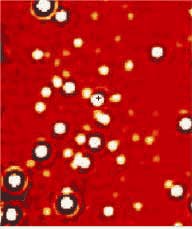Star in center of Milky Way confirms black hole
A remarkable report of a star closely orbiting the center of the galaxy gives the first conclusive evidence that a black hole exists there. An international team of astronomers, lead by researchers at the Max-Planck Institute for Extraterrestrial Physics (Garching, Germany), has directly observed an otherwise normal star orbiting the supermassive black hole at the center of the Milky Way Galaxy (see figure). Ten years of careful observations were crowned by a series of images taken with the Nasmyth adaptive optics system/Coudé near-infrared camera (NACO) instrument on the YEPUN 8.2-m Very Large Telescope at the European Southern Observatory (ESO; Paranal, Chile).
Black holes are believed to power the tremendous energy emitted by many galaxies and quasi-stellar radio sources (quasars). To produce such prodigious energy, black holes would have to be at least a million times more massive than the Sun. The radio and x-ray energy emitting from black holes is believed to be caused by a disk of dark matter spinning around the black hole that releases gravitational energy as it falls in. The detection of dark mass concentrations in the central regions of quasars and other massive galaxies has supported this "accretion disk" theory.
However, evidence until now has been ambiguous, because current optical limitations do not allow the determination of the shape of the gravitational field around the center of the Milky Way. The NACO instrument has captured the most detailed images of the Galactic Center yet, resolving the position of the compact radio source Sagittarius A (SgrA*) to 0.060 arcsec. The team, led by Rainer Schödel, Thomas Ott, and Reinhard Genzel from MPE, combined the infrared images from NACO with high-resolution radio data to determine the positions of 1000 stars nearest to SgrA*.
By chance, the star currently closest to SgrA*, designated "S2," was observed to rapidly swing around the radio source, approaching to within 17 light-hours (18.36 billion km) in an elliptical orbit. Such an event had never been recorded. "When we included the latest NACO data in our analysis, we could not believe our eyes," says Ott. The orbit of S2 is three times the distance from the Sun to Pluto—very close in stellar terms, with a period of 15.2 years.
The data leads to a best estimate for the mass of the black hole of (2.6 ±0.2) million solar masses. Also, the possible volume containing the required mass "shrinks" by a factor of several thousand. In fact, the data from the Galactic Center unequivocally discounts other explanations of the observations, such as a dense cluster of dark stellar objects.
A future planned interferometer using the Large Binocular Telescope (Milan, Italy), the ESO Very Large Telescope, and the Keck interferometer (Mauna Kea, HI) could resolve details a few light hours from the Galactic Center.
REFERENCE
- R. Schödel et al., Nature 419, 694 (2002).

